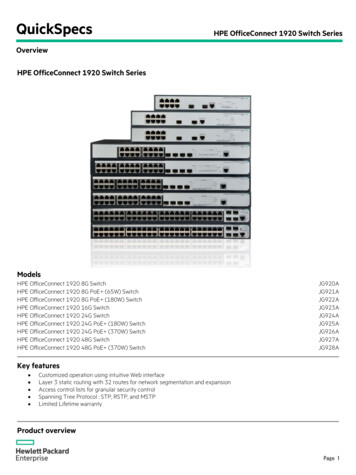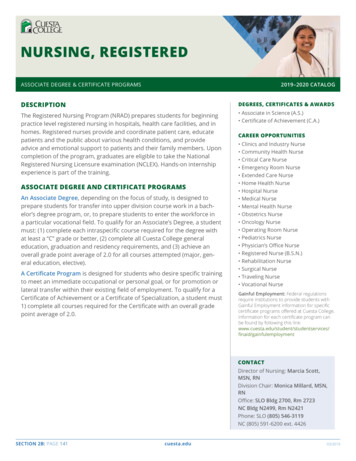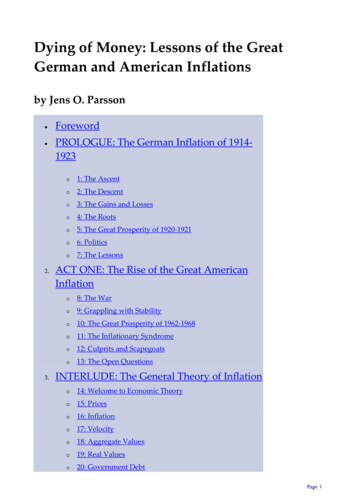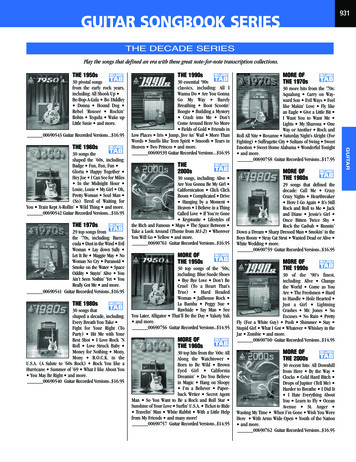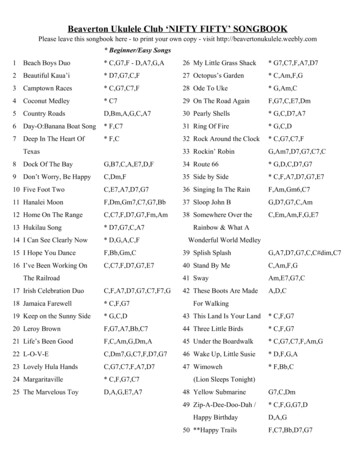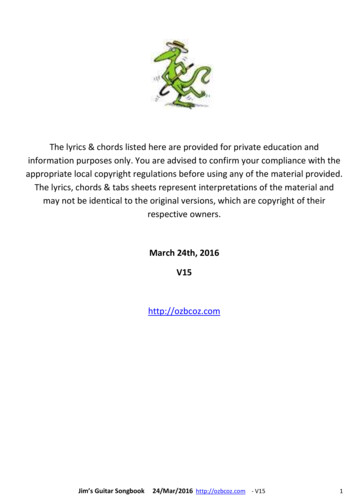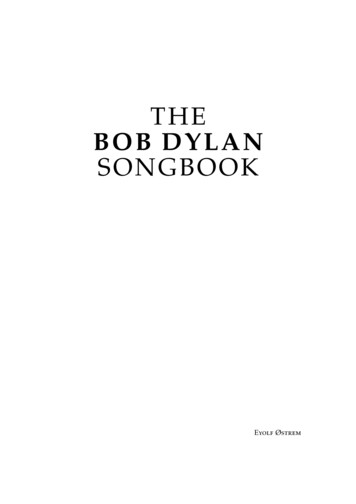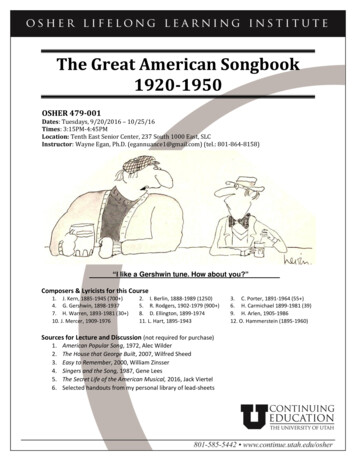
Transcription
The Great American Songbook1920-1950OSHER 479-001Dates: Tuesdays, 9/20/2016 – 10/25/16Times: 3:15PM-4:45PMLocation: Tenth East Senior Center, 237 South 1000 East, SLCInstructor: Wayne Egan, Ph.D. (egannuance1@gmail.com) (tel.: 801-864-8158)“I like a Gershwin tune. How about you?”Composers & Lyricists for this Course1. J. Kern, 1885-1945 (700 )4. G. Gershwin, 1898-19377. H. Warren, 1893-1981 (30 )10. J. Mercer, 1909-19762. I. Berlin, 1888-1989 (1250)5. R. Rodgers, 1902-1979 (900 )8. D. Ellington, 1899-197411. L. Hart, 1895-1943Sources for Lecture and Discussion (not required for purchase)1.2.3.4.5.6.American Popular Song, 1972, Alec WilderThe House that George Built, 2007, Wilfred SheedEasy to Remember, 2000, William ZinsserSingers and the Song, 1987, Gene LeesThe Secret Life of the American Musical, 2016, Jack ViertelSelected handouts from my personal library of lead-sheets3. C. Porter, 1891-1964 (55 )6. H. Carmichael 1899-1981 (39)9. H. Arlen, 1905-198612. O. Hammerstein (1895-1960)
Activities / SequenceThe Creative Era, a “movement” of sortsPreliminaries and Definitions Melody, harmony, rhythm, lyrics Syncopation and improvisation Songsa standarda bluesSept 20Intro&J. Kerntheater/stage songmovie song What do we admire in a great song?What does the lyricist do? (images, idioms, surprise)Evolution of the popular songAnatomy of the popular song—verse, chorus, and lyricAnatomy of American musicals (the Golden Era)Songs of Jerome Kern They Didn’t Believe Me (1914)* Look for the Silver Lining (1920) Smoke Gets In Your Eyes (1933) I Won’t Dance (1934) A Fine Romance (1936)Sept 27I. Berlinand G.Gershwinjazz songlove song The Song is You (1932)The Way You Look Tonight(1934) All the Things You Are (1939) Long Ago and far Away(1944)* from Girl from Utah musical,1914Activities / SequenceTransition to the “jazz song” (1930s brought greater sophistication) Most pop songs of the 20s show only scant reaction to the sounds emerging fromjazz bands, dance orchestras, piano players, and blues singers. Most pop songs of the 20s show only scant reaction to the sounds emerging fromjazz bands, dance orchestras, piano players, and blues singers. Most of that reaction came from black writers. H. Carmichael and I. Berlin: exceptionally aware white composers It would take the 1930s to provide the true meeting and blending between thenewsound makers and the song writers.Songs of Irving Berlin What’ll I Do? (1924)Isn’t This a Lovely Day (1935) Always (1925)I’ve Got My Love to Keep Me Warm (1937) Blue Skies (1927)Change Partners (1938) How Deep Is the Ocean? (1932) Cheek to Check (1934)Songs of George Gershwin The Man I Love (1924) Someone to Watch Over Me (1926) How Long Has This Been Going On? (1927)
Embraceable You (1930)Our Love is Here to Stay (1937)Songs of Cole Porter What is This Thing Called Love? (1929)Oct 4 Let’s Fall in Love (1928)You Do Something to Me (1929)After You (1932)Night and Day (1932)C. Porter&HoagySongs of Hoagy CarmichaelCarmichael Georgia on My Mind (1930)(S. Gorrell) The Nearness of You (1937) (N.Washington) Two Sleepy People (1938) (F. Loesser)I Get a Kick Out of You (1934)Easy to Love (1936)I Concentrate on You (1939)I Love You (1943)Every Time We Say Goodbye (1944) Skylark (1941) (J. Mercer)Stardust (1927) (M. Parish)Blue Orchids (1939) (Hoagy C.)
Songs of Richard Rodgerswith L. HartOct 11RichardRodgers with O. HammersteinYou Took Advantage of Me (1928) People Will Say We’re In Love (1943)Manhattan (1925)Might As Well be Spring (1945)Isn’t It Romantic (1932)Some Enchanted Evening (1949)Blue Moon (1934)This Nearly Was Mine (1949)My Romance (1935)I Have Dreamed (1951)My Funny Valentine (1937Hello Young Lovers (1951)Bewitched (1941)You’ll Never Walk Alone (1945)There’s a Small Hotel (1936)Where or When (1937)It’s Easy to Remember (1934)No class on October 18n.b.Activities / SequenceSongs / Lyrics by Johnnie Mercer Goody Goody (1936) Day In Day Out (1939) (Rube Bloom)Oct 25HarryWarren& JohnnieMercer I Thought About You (1939) (Van Heusen)Fools Rush In (1941) (Rube Bloom)This Time the Dream’s On Me (1941) (Arlen)I’m Old Fashioned (1942) (J. Kern)Songs of Harry Warren You’re My Everything (1931) I Only Have Eyes for You (1934) There Will Never Be Another You (1942) I Had the Craziest Dream (1942)I Remember You (1942) (Schertzinger)Out of This World (1945) (Arlen)Laura (1945) (Raskin)Satin Doll (1953) (Ellington)Something’s Gotta Give (1954)I Wanna Be Around (1959)At Last (1942)Serenade in Blue (1942)You’ll Never Know (1943)I Wish I Knew (1945)
Demonstration of select songs with a rhythm sectionDiscuss the transitions to: Rock ‘n’ rollBebop jazzCool jazzNew era for theater songsNov 1Songbook(notrequired)Other Prominent Composers (Van Heusen, Ellington, Lane) Prelude to A Kiss (1938) (D. Ellington) How About You (1941) (B. Lane) I’m Beginning to See the Light (1944) (D. Ellington) Darn That Dream (1939) (Van Heusen) Imagination (1940) (J. Burke, Van Heusen) Like Someone in Love (1944) (J. Van Heusen, J. Burke) It Could Happen to You (1944) (J. Van Heusen, J. Burke) But Beautiful (1947) (J. Van Heusen, J. Burke) Satin Doll (1953) (D. Ellington)Great Songs of the 1950s/60s Too Late Now (1950) (A. J. Lerner, B. Lane) Here’s That Rainy Day (1953) (J. Van Heusen, J. Burke) Witchcraft (1957) (Cy Coleman, Carolyn Leigh) The Second Time Around (1960) (J. Van Heusen, S. Cahn) Moon River (1961) (J. Mercer, H. Mancini) The Shadow of Your Smile (Johnny Mandel, 1964)An optional songbook of the tunes discussed in the class is available for purchase—probably best for those who can read music. The cost is approx. 20.00. Ask Dr. Egan forinformation on obtaining the songbook compilation. Call him if you want it for the firstsession of the class.
Songbook An optional songbook of the tunes discussed in the class is available for purchase (not required) — probably best for those who can read music. The cost is approx. 20.00. Ask Dr. Egan for information on obtaining the songbook compilation. Call him
